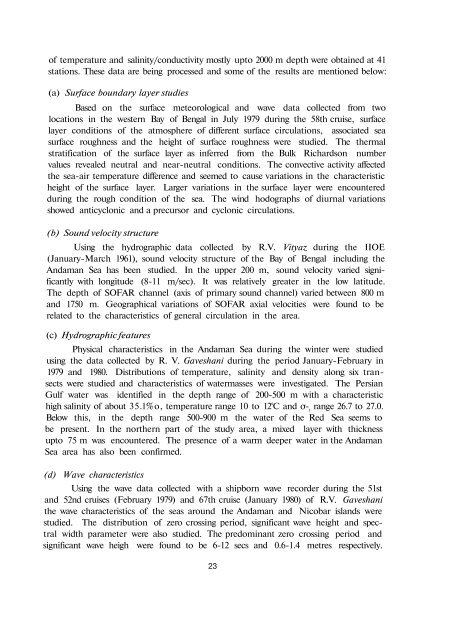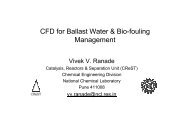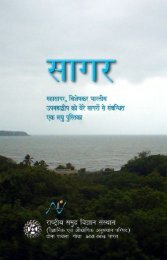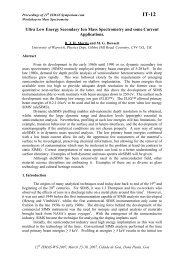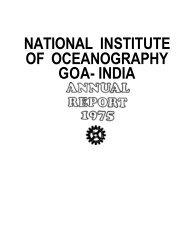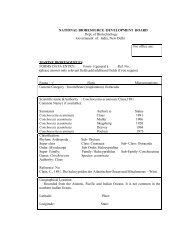1980 - National Institute of Oceanography
1980 - National Institute of Oceanography
1980 - National Institute of Oceanography
Create successful ePaper yourself
Turn your PDF publications into a flip-book with our unique Google optimized e-Paper software.
<strong>of</strong> temperature and salinity/conductivity mostly upto 2000 m depth were obtained at 41<br />
stations. These data are being processed and some <strong>of</strong> the results are mentioned below:<br />
(a) Surface boundary layer studies<br />
Based on the surface meteorological and wave data collected from two<br />
locations in the western Bay <strong>of</strong> Bengal in July 1979 during the 58th cruise, surface<br />
layer conditions <strong>of</strong> the atmosphere <strong>of</strong> different surface circulations, associated sea<br />
surface roughness and the height <strong>of</strong> surface roughness were studied. The thermal<br />
stratification <strong>of</strong> the surface layer as inferred from the Bulk Richardson number<br />
values revealed neutral and near-neutral conditions. The convective activity affected<br />
the sea-air temperature difference and seemed to cause variations in the characteristic<br />
height <strong>of</strong> the surface layer. Larger variations in the surface layer were encountered<br />
during the rough condition <strong>of</strong> the sea. The wind hodographs <strong>of</strong> diurnal variations<br />
showed anticyclonic and a precursor and cyclonic circulations.<br />
(b) Sound velocity structure<br />
Using the hydrographic data collected by R.V. Vityaz during the IIOE<br />
(January-March 1961), sound velocity structure <strong>of</strong> the Bay <strong>of</strong> Bengal including the<br />
Andaman Sea has been studied. In the upper 200 m, sound velocity varied significantly<br />
with longitude (8-11 m/sec). It was relatively greater in the low latitude.<br />
The depth <strong>of</strong> SOFAR channel (axis <strong>of</strong> primary sound channel) varied between 800 m<br />
and 1750 m. Geographical variations <strong>of</strong> SOFAR axial velocities were found to be<br />
related to the characteristics <strong>of</strong> general circulation in the area.<br />
(c) Hydrographic features<br />
Physical characteristics in the Andaman Sea during the winter were studied<br />
using the data collected by R. V. Gaveshani during the period January-February in<br />
1979 and <strong>1980</strong>. Distributions <strong>of</strong> temperature, salinity and density along six transects<br />
were studied and characteristics <strong>of</strong> watermasses were investigated. The Persian<br />
Gulf water was identified in the depth range <strong>of</strong> 200-500 m with a characteristic<br />
high salinity <strong>of</strong> about 35.l%o, temperature range 10 to 12°C and σ- t range 26.7 to 27.0.<br />
Below this, in the depth range 500-900 m the water <strong>of</strong> the Red Sea seems to<br />
be present. In the northern part <strong>of</strong> the study area, a mixed layer with thickness<br />
upto 75 m was encountered. The presence <strong>of</strong> a warm deeper water in the Andaman<br />
Sea area has also been confirmed.<br />
(d) Wave characteristics<br />
Using the wave data collected with a shipborn wave recorder during the 51st<br />
and 52nd cruises (February 1979) and 67th cruise (January <strong>1980</strong>) <strong>of</strong> R.V. Gaveshani<br />
the wave characteristics <strong>of</strong> the seas around the Andaman and Nicobar islands were<br />
studied. The distribution <strong>of</strong> zero crossing period, significant wave height and spectral<br />
width parameter were also studied. The predominant zero crossing period and<br />
significant wave heigh were found to be 6-12 secs and 0.6-1.4 metres respectively.<br />
23


